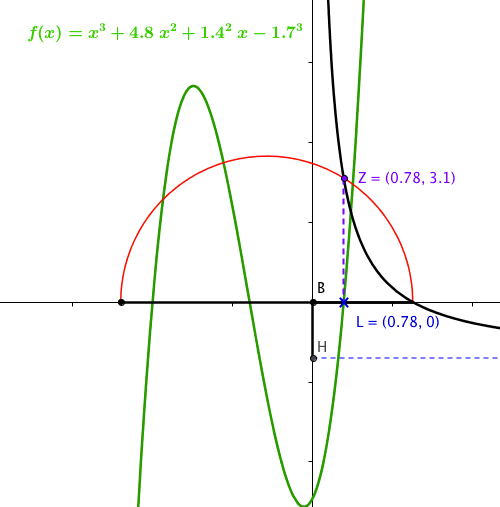- About MAA
- Membership
- MAA Publications
- Periodicals
- Blogs
- MAA Book Series
- MAA Press (an imprint of the AMS)
- MAA Notes
- MAA Reviews
- Mathematical Communication
- Information for Libraries
- Author Resources
- Advertise with MAA
- Meetings
- Competitions
- Programs
- Communities
- MAA Sections
- SIGMAA
- MAA Connect
- Students
- MAA Awards
- Awards Booklets
- Writing Awards
- Teaching Awards
- Service Awards
- Research Awards
- Lecture Awards
- Putnam Competition Individual and Team Winners
- D. E. Shaw Group AMC 8 Awards & Certificates
- Maryam Mirzakhani AMC 10 A Awards & Certificates
- Two Sigma AMC 10 B Awards & Certificates
- Jane Street AMC 12 A Awards & Certificates
- Akamai AMC 12 B Awards & Certificates
- High School Teachers
- News
You are here
A GeoGebra Rendition of One of Omar Khayyam's Solutions for a Cubic Equation - Combining Khayyam's Construction with a Modern Graph
Notably, Khayyam's construction generates a single line segment \(\overline{LB}\) which solves the cubic equation of the form \(x^3 + C_1x^2 + C_2x = C_3,\) where \(C_1,C_2,C_3>0.\) In Figure 6 and Figure 7, for an example, we have fixed the coefficients to be \(x^3 + 7.9x^2 + 1.3^2 x = 2.1^3,\) and in Figure 10, below, our example is \(x^3 + 4.8x^2 + 1.4^2 x = 1.7^3.\) In Figure 10, we have reflected Khayyam's construction about the line \(\overline{HB},\) the vertical asymptote of the hyperbola. Then, superimposing a Cartesian graph of a cubic shows clearly that \(BL\) corresponds exactly to the positive root of the cubic.

Figure 10. A reflection of Khayyam's construction for \(x^3 + 4.8x^2 + 1.4^2 x = 1.7^3,\) superimposed with a Cartesian graph of the equivalent cubic function. We take line segment \(\overline{HB},\) an asymptote for the hyperbola, as a vertical axis and line segment \(\overline{BL}\) to have length \(x\), which is exactly the value of a root to the cubic polynomial.
The slider bars in the GeoGebra applet in Figure 11 (below) enable students to explore how Khayyam's construction works for cubics with a range of coefficients. This dynamic exploration facilitates an appreciation of the general nature of the proof – Khayyam's method is not simply constructing one root to one specific polynomial. His construction technique constructs one root for any polynomial of the form \(f(x) = x^3 + C_1x^2 + C_2x - C_3,\) where \(C_1, C_2, C_3 > 0.\) The applet also presents in an accessible visual form the relationship between Khayyam's line segment \(\overline{LB}\) and a root of the cubic graph familiar to many students.
Figure 11. A reflection of Khayyam's construction for \(x^3 + ax^2 + b^2 x = c^3,\) with various positive values of \(a,b,\) and \(c,\) superimposed with a Cartesian graph of the equivalent cubic function. We take line segment \(\overline{HB},\) an asymptote for the hyperbola, as a vertical axis and line segment \(\overline{BL}\) to have length \(x\), which is exactly the value of a root to the cubic polynomial.
In Figures 10 and 11, superimposing a Cartesian graph of a cubic shows clearly that \(BL\) corresponds exactly to the positive root of the cubic. But what of the other roots?
Deborah Kent (Drake University) and Milan Sherman (Drake University), "A GeoGebra Rendition of One of Omar Khayyam's Solutions for a Cubic Equation - Combining Khayyam's Construction with a Modern Graph," Convergence (August 2015)




